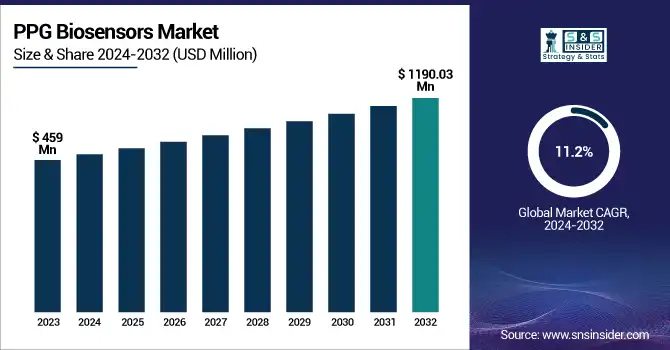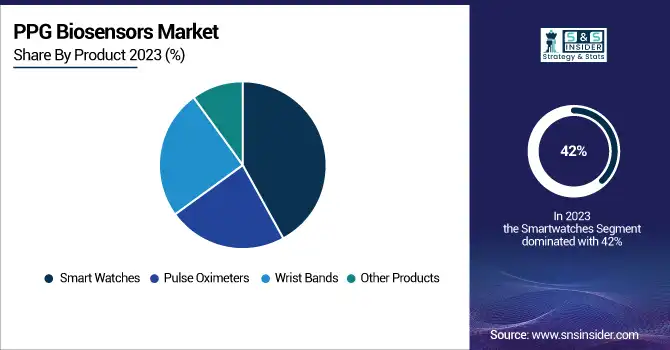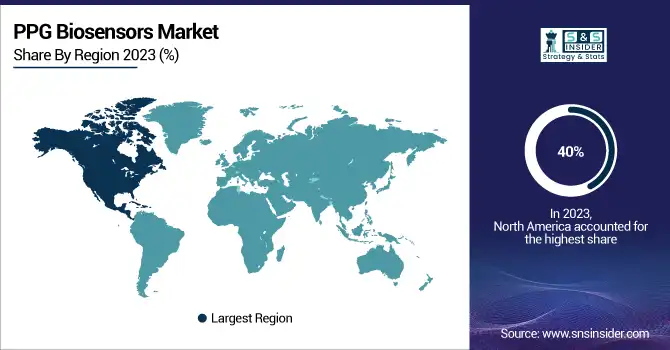PPG Biosensors Market Report Scope & Overview:
The PPG Biosensors Market Size was valued at USD 459 million in 2023 and is expected to reach USD 1190.03 million by 2032, growing at a CAGR of 11.2% over the forecast period 2024-2032.

To Get more information on PPG Biosensors Market - Request Free Sample Report
This report provides comprehensive statistical insights and emerging trends in the Photoplethysmography (PPG) Biosensors market. It includes the incidence and prevalence of major target conditions that drive the demand for PPGs, including cardiovascular and respiratory disorders. It also analyzes global healthcare spending on PPG-enabled solutions segmented on the basis of the payer types. It also examines integration with digital health platforms and compliance trends with regulators such as the FDA and CE. Through the inclusion of PPG biosensors in remote monitoring tools, chronic disease management, and the holistic digital health ecosystem, these insights reflect the evolution of PPG biosensors.
Growth of the Photoplethysmography (PPG) Biosensors Market is driven by the increasing adoption of wearable health technologies and government initiatives promoting preventive healthcare. According to the U.S. Department of Health and Human Services, approximately 48% of American adults have some form of cardiovascular disease, highlighting the need for real-time, non-invasive monitoring solutions like PPG biosensors. There was a remarkable increase in the size of the US Photoplethysmography (PPG) Biosensors Market, which grew from USD 145.04 million in 2023 to USD 372.28 million by 2032 during the forecast period. The market is already been showing a compound annual growth (CAGR)5 of 11.06% and is further expected to be driven further by the rising adoption of remote patient monitoring, cardiovascular health monitoring, and wearable medical devices.
Market Dynamics
Drivers
-
The growing adoption of smartwatches and fitness trackers with integrated PPG sensors for real-time heart rate and blood oxygen monitoring is fueling market growth.
The increase in demand for wearable health monitoring devices is a prominent factor that propels the growth of the Photoplethysmography (PPG) biosensors market. Over the last decade, an industry-wide movement toward proactive healthcare in tandem with growing consumer demand for real-time health information has pushed PPG-based wearables to the forefront. According to IDC's Worldwide Quarterly Wearable Device Tracker (2024), smartwatches made up more than a third of the over 500 million wearable devices shipped globally in 2023. Notably, a large portion of these smartwatches now include PPG sensors to track heart rate, blood oxygen saturation (SpO₂), and stress levels.
For example, the latest Apple Watch Series 9 and Galaxy Watch 6 by Samsung from late 2023, both get advanced PPG biosensors allowing them to monitor heart rate constantly and deliver irregular rhythm notifications. Due to rising user expectations, these features are now common in premium and mid-range devices. Additionally, a 2024 investigation conducted by Deloitte Digital Health found that more than 65% of wearable device users are monitoring at least one health parameter, with heart rate being the most tracked parameter. Such behavioural trend is propelling OEMs to integrate high-performance PPG biosensors for accurate, non-invasive, and continuous monitoring.
Restraint:
-
PPG sensors are sensitive to movement, which can lead to unreliable readings during physical activities, limiting their use in dynamic environments.
One of the key restraints affecting the Photoplethysmography (PPG) biosensors market is the inaccuracy in measurements caused by motion artifacts. PPG sensors function by detecting blood volume changes through light absorption, typically at the skin's surface. However, when users engage in physical movement, especially during workouts, running, or other dynamic activities the readings can become distorted due to the relative motion between the sensor and the skin. This technical limitation affects the reliability of vital metrics such as heart rate variability and oxygen saturation. According to a 2024 study published in Sensors, motion artifacts contributed to an average signal distortion of up to 42% during high-intensity physical activity in consumer-grade PPG devices. Additionally, clinical-grade devices also showed an error margin of 18–25% under moderate motion scenarios. This poses significant concerns for both healthcare professionals and end-users relying on continuous monitoring data for medical or fitness applications. The problem is further intensified when PPG sensors are placed at peripheral sites like the wrist, where motion is more frequent and erratic. Although some recent advancements in signal processing and machine learning are being used to filter out noise, the issue remains a critical barrier to widespread clinical adoption and trust in consumer health monitoring tools.
Opportunity:
-
Advancements in AI algorithms and cloud connectivity offer scope for enhanced data analytics and remote health monitoring, creating new growth avenues for PPG biosensors.
The integration of Photoplethysmography (PPG) biosensors with AI and cloud-based platforms is one of the most significant opportunities in the market, as it enables continuous monitoring and diagnostic of body signals. Reflecting the increase in chronic health conditions and the drive toward personalized healthcare, real-time physiological data captured using PPG sensors is being harnessed with AI algorithms for medical prediction and detecting anomalies. Deloitte recently reported that more than 60% of wearable health tech companies will be integrating AI-driven health analytics into their wearables by 2024. This merger offers continuous monitoring of signals such as heart rate variability, oxygen saturation, and various other biometric measurements, enhancing the accuracy of early diagnoses and personalized health recommendations.
A 2024 recent survey found that 74% of North American healthcare providers are investing in cloud-based remote patient monitoring systems, many of which use wearables containing PPG sensors. These platforms enable clinicians to flow data seamlessly, and access, and interpret it in real-time, which can be critical to managing conditions such as arrhythmia, hypertension, or sleep apnea. Fitbit (now with Google) and Apple have already added AI-powered health capabilities to new wearables. For instance, Apple’s Watch Series 9, uses machine learning models to identify irregular heart rhythms from PPG data, making another argument for the trend of intelligent biosensor systems backed by cloud infrastructure.
Challenge:
-
Ensuring data privacy and regulatory compliance With increasing data collection via wearables, manufacturers face challenges in meeting stringent data protection regulations and ensuring user trust.
One of the major challenges faced by the global Photoplethysmography (PPG) biosensors market is guaranteeing data privacy and adhering to the evolving regulatory requirements. Since PPG biosensors are commonly deployed in wearable health gadgets, they incessantly accumulate sensitive biometric information together with coronary heart fees, oxygen saturation, and sleep patterns. This explosion of data can be a massive headache to users in terms of privacy, potential data misuse, and security issues. A 68% of surveyed consumers said in a 2024, they are worried about how wearable health devices process their own information.
Regulations like Europe’s General Data Protection Regulation (GDPR) and the U.S.’s Health Insurance Portability and Accountability Act (HIPAA) mandate the rigorous ways in which health data can be used, stored, and transferred. Not complying with these regulations may incur legal ramifications and loss of brand trust. manufacturers and developers have to make a lot of investments in encryption, secure data transfer protocols and clear policies. PPG biosensor applications must also serve as a consistent solution to this complex, dynamic regulatory environment, which presents a significant challenge as applications continue to grow.
Segment analysis
By Product
In 2023, smartwatches dominated the PPG biosensors market with a significant share of 42%, primarily due to the increasing integration of holistic health monitoring capabilities and consumer preference towards wearables. PPG biosensors available on smartwatches enhance the user experience with easy, continuous measurement of vital parameters like heart rate, blood oxygen saturation, and stress levels. These devices have become increasingly popular among fitness enthusiasts and those managing chronic conditions as they are convenient and offer multiple functionalities.
Technological advancements have played a pivotal role in this segment's growth. Wearable giants such as Apple, Fitbit, and Garmin on the other hand have incorporated state-of-the-art PPG sensors in their smartwatches that utilize multi-wavelength technology for increased measurement accuracy. Light contributes for example to increase the effectiveness of heart rate monitoring by up to 20%, with green, red, and infrared light. Moreover, employing artificial intelligence (AI) algorithms to enhance data interpretation has allowed for actionable health insights. Healthcare is seeing increased utilization of smartwatches as the government stats show. More than 20 million smartwatches were sold in the U.S. in 2021 alone, according to the Consumer Technology Association. The Centers for Disease Control and Prevention (CDC) also reports that nearly 47% of U.S. adults suffer from hypertension, a condition that can benefit from continuous monitoring provided by wearable devices. This has led to increased usage of smartwatches for preventive healthcare.

By Application
Heart rate monitoring segment accounted for the largest market share 41% of the PPG biosensors market in 2023. This domination is due to the increasing prevalence of cardiovascular diseases (CVDs) and the growing demand for safe, non-invasive health monitoring solutions. The World Health Organization (WHO) estimates that CVDs are the leading cause of death globally, responsible for an estimated 17.9 million deaths annually. For example, this trend has alarming implications for the need for continuous heart rate monitoring which can help identify early warning signs. PPG biosensors are responsible for the heart rate monitor in smartwatches and fitness trackers, collecting data in real-time. This light-based technology is used to accurately measure blood volume changes in microvascular tissues and provide accurate cardiovascular health metrics noninvasively. The use of these tools renders tools available to a wider population simply because of their incorporation into everyday wearables. Further contributing to the growth of this segment has been a slew of government initiatives. For example, Medicare reimbursement policies now cover remote patient monitoring devices with PPG sensors. This has encouraged healthcare providers to adopt wearable technology for chronic disease management and post-operative care.
Regional Analysis
The North American region held the highest PPG biosensors Market share 40% in 2023 due to its sophisticated healthcare infrastructure and wide adoption of wearable technologies. A significant portion of this regional dominance belongs to the U.S., where strong consumer demand for smartwatches and fitness trackers with PPG sensors has been evident. According to CDC data, nearly 47% of U.S. adults have hypertension, creating demand for continuous health monitoring solutions. The region’s leadership in technology has played a key role in its dominance of the market. Key companies such as Apple and Fitbit are based in North America, driving advancements in PPG sensor technology. Furthermore, government initiatives that promote telemedicine and remote patient monitoring are other important factors in market growth. For example, the recent Medicare coverage expansion of remote monitoring devices has led to broad adoption by healthcare providers.
The Asia-Pacific region is expected to witness the highest CAGR during the forecast period due to increasing healthcare expenditure and growing awareness about preventive healthcare solutions. This growth is driven by countries such as India and China with their fast adoption of wearables. Policies initiated by the government for the use of digital health solutions have also formed a positive environment for market growth. A vast population base in this region outlines lucrative opportunities for the PPG biosensor manufacturers. Demand for fitness trackers and smartwatches is soaring as disposable income rises and health consciousness increases among consumers. Moreover, the increasing incidence of chronic illnesses like diabetes and hypertension has increased the demand for good health management tools.

Get Customized Report as per Your Business Requirement - Enquiry Now
Key Players
Key Service Providers/Manufacturers
-
Maxim Integrated (Analog Devices, Inc.) – (MAX30102, MAX30105)
-
Texas Instruments Incorporated – (AFE4404, AFE4950)
-
ams-OSRAM AG – (AS7038RB, AS7026GG)
-
Murata Manufacturing Co., Ltd. – (SCA3300, SCC3000 Series)
-
LITE-ON Technology Corporation – (LTPS-33R, LTP-3050)
-
Viatom Technology Co., Ltd. – (Checkme Pro, Pulsebit EX)
-
Shimmer Sensing – (Shimmer3 GSR+, Shimmer3 Optical Pulse Sensor)
-
Biosensics LLC – (Biosensics PPG Sensor, Mobility Lab Sensor)
-
Protonic Medical Systems – (ProPulse, PPG Wristband Monitor)
-
Medtronic plc – (VitalSync, Nellcor Pulse Oximeters)
Key Users
-
Apple Inc.
-
Fitbit (a Google company)
-
Samsung Electronics Co., Ltd.
-
Garmin Ltd.
-
Huawei Technologies Co., Ltd.
-
Xiaomi Corporation
-
Withings SA
-
Polar Electro Oy
-
Omron Healthcare, Inc.
-
Philips Healthcare
Recent Developments
-
In January 2025, Murata launched a new line of ultra-miniaturized PPG sensors designed for seamless integration into compact wearable devices.
-
In February 2025, MediaTek introduced a chipset optimized for wearable devices that enhances PPG sensor performance through AI-driven analytics.
| Report Attributes | Details |
|---|---|
| Market Size in 2023 | USD 459 Million |
| Market Size by 2032 | USD 1190.03 Million |
| CAGR | CAGR of 11.2% From 2024 to 2032 |
| Base Year | 2023 |
| Forecast Period | 2024-2032 |
| Historical Data | 2020-2022 |
| Report Scope & Coverage | Market Size, Segments Analysis, Competitive Landscape, Regional Analysis, DROC & SWOT Analysis, Forecast Outlook |
| Key Segments | • By Product (Pulse Oximeters, Wrist Bands, Smart Watches, Other Products) • By Application (Heart Rate Monitoring, Blood Pressure, Blood-oxygen Saturation, Other Applications) |
| Regional Analysis/Coverage | North America (US, Canada, Mexico), Europe (Eastern Europe [Poland, Romania, Hungary, Turkey, Rest of Eastern Europe] Western Europe] Germany, France, UK, Italy, Spain, Netherlands, Switzerland, Austria, Rest of Western Europe]), Asia Pacific (China, India, Japan, South Korea, Vietnam, Singapore, Australia, Rest of Asia Pacific), Middle East & Africa (Middle East [UAE, Egypt, Saudi Arabia, Qatar, Rest of Middle East], Africa [Nigeria, South Africa, Rest of Africa], Latin America (Brazil, Argentina, Colombia, Rest of Latin America) |
| Company Profiles | Maxim Integrated (Analog Devices, Inc.), Texas Instruments Incorporated, ams-OSRAM AG, Murata Manufacturing Co., Ltd., LITE-ON Technology Corporation, Viatom Technology Co., Ltd., Shimmer Sensing, Biosensics LLC, Protonic Medical Systems, Medtronic plc |

